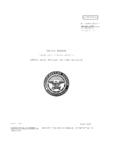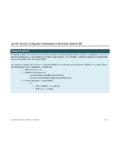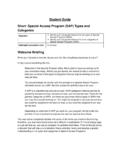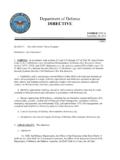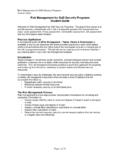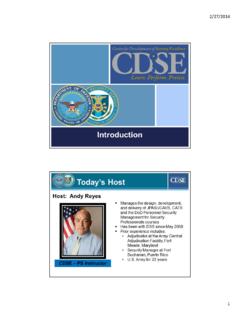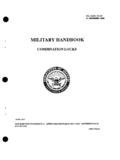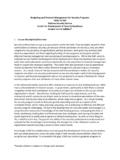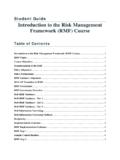Transcription of Safeguarding Classified Information in the NISP
1 Safeguarding Classified Information in the NISP Product #: IS109 Student Guide Center for Development of Security Excellence (CDSE) 1 Safeguarding Classified Information in the NISP Course Introduction Course Information Narration: Welcome to the Safeguarding Classified Information in the National Industrial Security Program, or NISP, Course. Screen text: Safeguarding Classified Information in the NISP Course Information Purpose: Provide a thorough understanding of the requirements for Safeguarding Classified material in the NISP as delineated in the National Industrial Security Program Operating Manual (NISPOM) Audience: Contractor Facility Security Officers Security staff of cleared DoD contractors participating in the NISP DSS Industrial Security Representatives DoD Industrial Security Specialists Pass/Fail: 75% on final examination Estimated completion time.
2 150 minutes Course Resources Course Overview Narration: Safeguarding Classified Information is imperative for our national security. Safeguarding Classified Information means being able to securely receive, use, store, transmit, reproduce, and appropriately dispose of Classified Information either generated by or entrusted to your company. Requirements for Safeguarding Classified Information in the NISP are stated in DoD , the National Industrial Security Program Operating Manual, or NISPOM. In this course, you will learn about the measures you and your company must take to ensure that Classified Information is protected from loss or compromise.
3 Screen text: Safeguarding Classified Information in the NISP Product #: IS109 Student Guide Center for Development of Security Excellence (CDSE) 2 Safeguard Classified Information when: Receiving Using Storing Transmitting Reproducing Disposing For more Information see NISPOM Chapter 5: Safeguarding Classified Information Course Objectives Screen text: Course Objectives: Identify the general requirements for Safeguarding Classified Information Identify the requirements for control and accountability of Classified Information Identify options and requirements for storage of Classified Information Identify requirements for disclosure of Classified Information Identify requirements for reproduction of Classified Information Identify requirements for disposition of Classified Information Course Structure Screen text.
4 Lessons Course Introduction Basic Concepts Obtaining Classified Information Storing Classified Information Using Classified Information Reproducing Classified Information Disposition of Classified Information Practical Exercise Course Conclusion Safeguarding Classified Information in the NISP Product #: IS109 Student Guide Center for Development of Security Excellence (CDSE) 3 Basic Concepts Lesson Introduction Narration: Before you learn about the various measures for Safeguarding Classified Information , there are some concepts related to Safeguarding that you should know.
5 This lesson will familiarize you with these concepts. Screen text: Basic Concepts Lesson Objectives: Distinguish between the different types of Classified Information Identify the disclosure requirements for Classified Information Identify the Information management requirements for Classified Information Classification Levels Narration: Classified Information is categorized into three classification levels, Confidential, Secret, and Top Secret. Classification levels are applied to national security Information that, if subject to unauthorized disclosure, could reasonably be expected to cause damage, serious damage, or exceptionally grave damage to national security.
6 Each classification level has its own requirements for Safeguarding . The higher the level of classification, the more protection the Classified Information requires to reasonably prevent the possibility of its loss or compromise. Screen text: Classified Information : Levels of classification: o CONFIDENTIAL o SECRET o TOP SECRET Specific Safeguarding requirements for each level Higher classification levels require more protection CONFIDENTIAL rollover text: The classification level applied to Information , the unauthorized disclosure of which reasonably could be expected to cause damage to the national security that the original classification authority is able to identify or describe.
7 SECRET rollover text: The classification level applied to Information , the unauthorized disclosure of which reasonably could be expected to cause serious damage to the national security that the original classification authority is able to identify or describe. Safeguarding Classified Information in the NISP Product #: IS109 Student Guide Center for Development of Security Excellence (CDSE) 4 TOP SECRET rollover text: The classification level applied to Information , the unauthorized disclosure of which reasonably could be expected to cause exceptionally grave damage to the national security that the original classification authority is able to identify or describe.
8 Forms of Classified Information Narration: All forms of Classified Information must be protected. Forms of Classified Information include Classified finished or final documents, both paper-based and electronic, Classified working papers, Classified waste, and classification-pending material. Classified working papers are documents that are generated in the preparation of a finished document. Classified waste is Classified Information that is no longer needed and is pending destruction. Classification-pending documents are documents that require a classification determination from the Government Contracting Activity, or GCA.
9 These documents must be safeguarded in accordance with the proposed highest classification level until guidance is received from the GCA. Throughout this course you will learn the Safeguarding requirements for each of these types of Classified Information . Screen text: You must safeguard all forms of Classified Information ! Classified Documents Working Papers Classified Waste Classification-Pending Documents Electronic Documents and Media Disclosure to Authorized Persons Narration: You must ensure that Classified Information is disclosed only to authorized persons. An authorized person is someone who has a need-to-know for Classified Information in the performance of official duties and who has been granted a personnel clearance at the required level.
10 So you are only authorized to disclose Classified Information to your cleared employees, to another cleared contractor or sub-contractor, to a cleared parent company or subsidiary, within a multiple facility organization, or MFO, to DoD activities, or to Federal agencies when their access is necessary for the performance of tasks or services essential to the fulfillment of a Classified contract, prime contract, or subcontract. Safeguarding Classified Information in the NISP Product #: IS109 Student Guide Center for Development of Security Excellence (CDSE) 5 Note that disclosure of Classified Information may be done in oral form.
